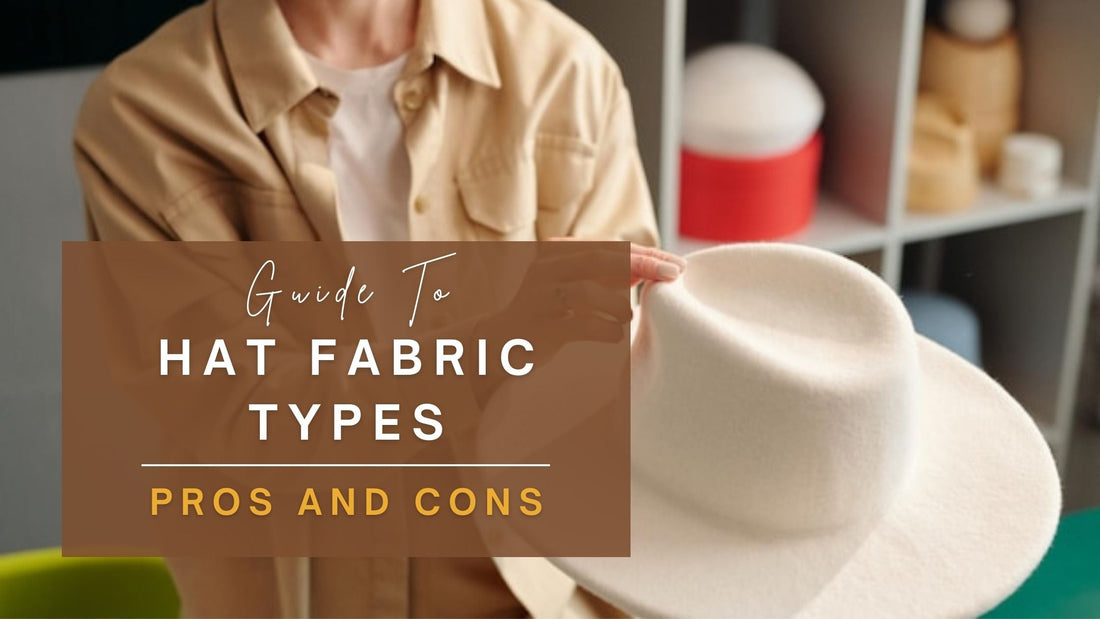Selecting the right material or fabric for a hat is essential for convenience as well as for styling. Learning the various hat fabrics will help you make a smart choice whether you are looking for a casual hat or a luxury hat for an event or an occasion.
In this blog, we'll discuss different hat fabrics, their pros and cons, and how to choose the best fabric for hats.
11 Different Types Of Hat Fabrics

For years, hats have been an essential part of clothing, serving both utility and fashion. Hats are available in different types of materials, each with their distinctive qualities. It can be used not only for protection from the sun but also to make a unique or striking fashion statement. The hat's overall appearance, comfort, and longevity can all be greatly impacted by the material you select.
Here is the list of different types of hat fabrics which are commonly used with their pros and cons.
1. Cotton Fabric

Cotton is a popular choice for hat material and can be used mainly due to its comfort and breathability. Cotton fabric hats are soft and gentle on the skin and hence, they are most suitable for sensitive people. Cotton hats are more economical than any other hat fabric.
Cotton tends to shrink easily and get wrinkles, which makes them less durable. As a result, they are not the best for daily use. Cotton fabric hats are perfect for warm weather as they absorb moisture and due to their breathability.
Hats with Cotton Fabric: Baseball caps, Trucker hats, Dad hats, Bucket hats, Beanies, Skull caps, Sun hats, Newsboy caps or Flat caps, Cadet caps or Military caps.
Pros:
- Comfortable and soft
- Affordable
- Breathable
- Lightweight
- Easy to care
Cons:
- Tends to shrink
- Prone to wrinkles
- Less durable
2. Wool Fiber

Another natural fiber that has been utilized for generations in the hat-making industry is wool. Wool is highly durable and is capable of providing warmth. Wool hat fabric is ideal for the winter season as it is best to keep your head warm. Its fabric is delicate and soft, and it is capable of absorbing sweat. Wool is generally expensive compared to other fabrics, and it requires proper care to maintain its softness.
Hats with Wool Fabric: Beanies, Fedora, Beret, Newsboy cap, Trapper hat, Cloche hat, Homburg hat.
Pros:
- Durable
- Moisture-wicking properties or water resistance
- Keep you warm
- Breathable
Cons:
- Expensive
- Prone to damage if not cared for properly
- For some people, itching
3. Felt Fabric

Felt is often used material for hats. Felt hat fabrics are versatile. They are created by pressing and matting wool fibers together, which makes them durable and long-lasting. They come in a wide range of color options and are perfect for a classy and sophisticated appearance. They have water-resistant properties and are wearable in any season.
Felt fabric is prone to damage or lose its shape if not stored properly. Also, felt fabrics are more expensive than other hat materials.
Hats with Felt Fabric: Fedora, Trilby, Homburg, Bowler, Cloche, Cowboy hat, Porkpie, Floppy hat.
Pros:
- Water-resistant
- Durable
- Versatile
- Wide range of textures and colours
Cons:
- Expensive
- Prone to damage
4. Leather Material

Leather is a common material for hats because of its durability. Leather hats can easily endure wear and tear and have water-resistant qualities. They are renowned for looking opulent. Hats made with leather are very costly. They work best with cowboy hats, aviator hats, and fedoras.
Hats with Leather Fabric: Cowboy hats, Outback hats, Trapper hats, Aviator hats, Flat caps, Fedora hats, Baseball caps.
Pros:
- Highly Durable
- Water-resistant
- Timeless appearance
- Aging can create a beautiful patina in the hat, making it more elegant
Cons:
- Highly expensive
- Discomfort or allergic to some people
- Impact on the environment due to the use of heavy chemicals in tanning process
5. Polyester Fabric

Polyester is a synthetic material popularly known for its toughness and quick-drying qualities. They are perfectly suitable for outdoor activities and for people who sweat a lot. Polyester hat fabric is not as soft as cotton, so they are not wearable in hot conditions. Polyesters are economical and easy to maintain.
Hats with Polyester Fabric: Baseball caps, Snapback caps, Trucker hats, Dad hats, Fitted caps, Sports and Performance hats, Bucket hats, Beanies.
Pros:
- Lightweight
- Water-resistant properties
- Durable
- Ideal for outdoor activities
Cons:
- Not comfortable compared to other materials
6. Acrylic

Acrylic is a type of synthetic fiber used in place of wool. Acrylic is known for its durability, softness, and warmth. This fabric is ideal for the winter season. Compared to wool, acrylic hat fabric is less expensive. Also, it is not as soft as wool and sometimes feels harsh on the skin. It fades after multiple uses or washing.
Hats with Acrylic Fabric: Beanies, Knit caps, Duckbill caps, Baseball-style caps.
Pros:
- Less expensive than wool and other natural fibers
- Ideal choice for cold weather
- Known for its softness
- Easy to maintain
Cons:
- Sometimes harsh to the skin
- Not comfortable like natural fabrics
- Get fade over time
- Less breathable
7. Nylon

This polymer-based substance is renowned for being breathable, lightweight, and—above all—extremely durable. It can easily survive inclement weather, such as snow and rain. Because nylon hat fabric is lightweight, nylon hats are appropriate for active wear. In warm temperatures, nylons are less comfortable. Outdoor hats and bucket hats are generally manufactured using nylon fabric.
Hats with Nylon Fabric: Trucker hat, Baseball cap, Bucket hat, Booney hat, Rain hat, Outdoor/Hiking hat.
Pros:
- Lightweight and durable
- Withstand harsh climate conditions
Cons:
- Ability to retain heat
- It is not as comfortable as natural fibers
8. Suede

Suede is popular for being an upscale fabric and gives a stylish look. They are produced using the animal skin's underside. Due to this reason, they are soft, have a velvety texture, and offer great comfortability. It requires high maintenance and special care as it tends to fade quickly compared to other hat materials. These hat fabrics are highly sensitive to water. As a result, it becomes more stiff.
Hats with Suede Material: Cowboy hats, Bucket hats, Baseball caps, Trucker hats, Fedora hats, Newsboy hats.
Pros:
- Luxurious and comfortable
- Durable
- Fashion statement
Cons:
- Prone to stains and fades faster than other fabrics
- Require special care and maintenance
- Sensitive to Water
9. Denim

Denim hats are long-lasting when compared to cotton hats because of their thicker material. Denim snapback types, distressed caps, and dad hats are all available. Opt for denim hat fabric if you want a classic retro look.
Hats with Denim Fabric: Visors, Baseball caps, Bucket hats, Trucker hats, Newsboy hats, Cowboy hats, Fedoras, and Beanies.
Pros:
- Durable
- Several uses, including accessories, clothing, decor, and more
- Easy to care
- Become softer after several wears
Cons:
- Denim is stiff and uncomfortable at first
- It can fade over time or by washing repeatedly
10. Straw

Straw hats have been a summer's mainstay for many years because they provide great sun protection and a breezy, laid-back style. It is made from natural plant fibres using dried grasses creating an open structure that lets air flow freely. Due to this porous structure, they are perfect for wearing hot weather. They are lightweight and breathable. They get easily damaged in water and require special care to prevent it.
Hats with Straw Material: Panama hat, Lifeguard hat, Boater hat, Fedora hat, Floppy hat, Cowboy hat, Conical hat.
Pros:
- Lightweight and durable
- Handmade with dried grasses
- Perfect for summers or beach days
Cons:
- Prone to damage or frayed if not stored properly
- May damage in water
11. Poly Mesh

The back panel of unisex trucker hats and other hat styles is where poly mesh is most frequently employed. However, this simple and lightweight hat material can also be used to make whole caps. Polymesh offers superior breathability and ventilation. Because of this, it's the perfect choice for the hat fabric in hot areas.
Hats with Poly Mesh Fabric: Snapbacks, Trucker caps, Baseball caps, Fitted caps, Beanies, Dad hats, Bucket hats.
Pros:
- Quick-drying
- Lightweight and durable
- Affordable
- Breathable material- ideal for warm weather (keeps you cool and comfortable)
Cons:
- Not ideal for sensitive skin
- Due to their weave pattern, they are not ideal for cold weather
- It is not as durable as natural fibers like cotton and wool
Things to Consider While Selecting Hat Fabrics
Before considering a particular hat material, it is important to take into account several elements that may affect your decision:
- Weather: Weather and climate conditions can also affect your decision regarding hat fabrics. For hot climates, go with more breathable options like cotton and straw. For cold weather, go for wool, felt, or acrylic.
- Purpose: Selecting hat fabric can also depend upon its intended use. For outdoor activities, go for more durable options. For casual wear, go for wool and cotton fabrics.
- Cost: The hat fabric may also be determined by the budget. It can range from luxurious to reasonably priced.
If you take into account the above points, as well as the pros and cons of each fabric, you will be better able to select a hat material that suits your specific needs and lifestyle.
CONCLUSION
Selecting the ideal hat material requires striking a balance between practicality, fashion, and personal preference. You can make an informed decision for your needs and improve your collection by learning about the characteristics of the different hat materials mentioned above.

